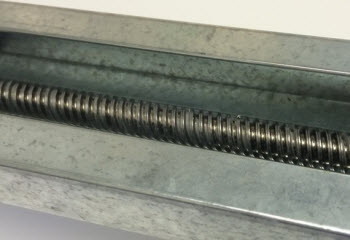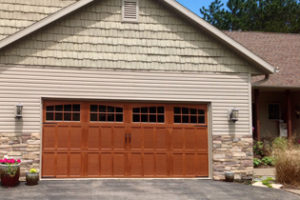If it weren’t for the springs in your garage door, there’s little chance that you’d be able to lift it unaided. By acting as a counterweight with a high torque that offsets the weight of the door, torsion or extension springs enable you to safely and easily lift the door, making them an essential element of any fully functioning and safe garage door.
Torsion springs:
These are commonly used on heavier garage doors and can usually be seen on the wall above the door.
Extension springs:
These springs are typically found above the horizontal tracks that the pulleys move on, or on the sides of a single garage door.
How can I tell if my garage door springs need to be replaced?
It can be tricky to see if a spring has stopped working effectively and might need to be replaced, but you will, however, be able to tell if they are failing due to the stress they are causing for other components. If the garage door pulleys, cables and rollers are showing any signs of wear and tear, or are making noises that you don’t usually hear, then it could be an indicator that the springs are faulty.
However, there is one strong sign that a spring has a problem, and that’s if you can see a separation. Maybe the spring looks as if it has been stretched beyond its usual parameters, and if so, this is usually a sign that the spring has lost its calibrated tension and needs to be assessed and possibly replaced or repaired. Try comparing the springs to see if they match as they should do.
What will usually happen when garage door springs fail?
Since springs should be tightly wound in order to function properly, if they have become weakened in any way, they will likely cause the garage door to fall with no countering resistance. This can be extremely dangerous for people and pets and can even result in death.
A failing spring will also make the garage door very hard to raise, and a garage door opener will face the same problem. In fact, if not spotted and addressed immediately, the garage door opener may malfunction, too.
What should you do if you’re uncertain whether the springs have failed?
You should seek professional help ideally, but if you do want to be sure before you call somebody: try lifting the door with the automatic opener disconnected. If you can’t easily raise it manually, or if it doesn’t remain in place once you have managed to lift it, then there’s a strong chance that the springs have broken or malfunctioned.
Can you fix a broken or damaged garage door spring yourself?
The energy stored in a spring is enough to cause serious harm to you or property if unreleased safely, making it a clear job for professionals who know what they’re doing and can assess the risk safely and efficiently. Never attempt to fix broken or damaged springs yourself, it’s simply not worth the risk.
Should I replace my garage door springs even if they’re functioning normally?
The lifespan of the springs on your garage door varies depending on how often they are used, but it’s safe to say that they will usually last from between 7 and 10 years for residential properties.
If your springs are reaching this age, it might be worth getting them checked over to establish whether there are any issues with general wear and tear and to know whether they should be replaced for the safety of you and your family.





